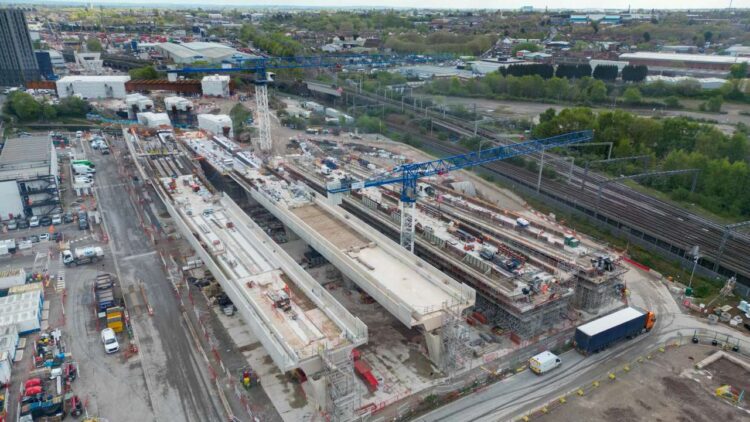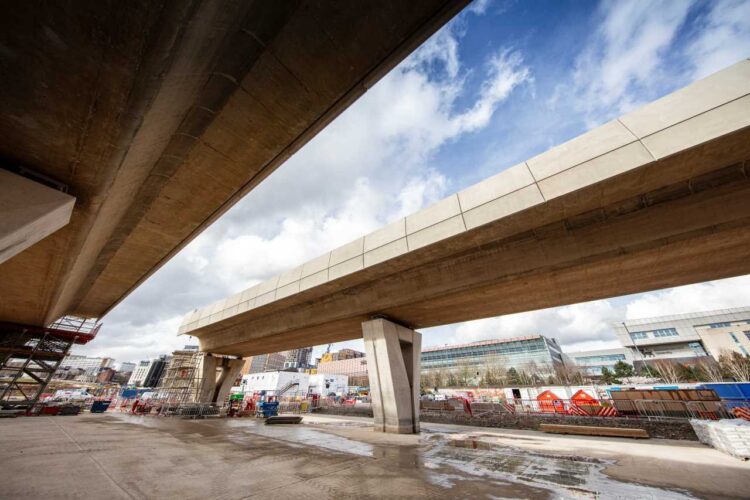With HS2 construction now at its peak, major parts of the project are coming on rapidly.
The latest part of the project to be completed is a large span of deck A, which is part of Curzon 3 viaduct, which sits to the outside of what will be HS2s terminal station in Birmingham.
This viaduct is the closest to Curzon street. For those travelling up from the London direction in future years on this line, trains will emerge from Bromford Tunnel, on to what will be five continuous viaducts on the last stretch of the HS2 line into Birmingham.
These viaducts all have names, those being Duddeston, Curzon 1, Curzon 2, Lawley Middleway and Curzon 3 viaducts.
The overall length of these five viaducts combined is approximately one mile, and they all carry the line from the countryside over the suburban and industrial areas of Birmingham into the heart of the city.
Curzon 3 viaduct is where the line widens from a double track (single deck) viaduct into seven lines (four decks) four parallel viaducts that will serve the platforms at Curzon Street.
Each of these viaducts is 6 metres tall and at the widest point measures 65 metres across all four parallel viaducts, each deck is named Deck A, B, C & D. The completion of the first span on Deck A is yet another major step forward in the building of HS2.

Balfour Beatty VINCI HS2s Midlands contractor is constructing the viaducts.
A vast diversified team with over 200 people, each skilled in different aspects of construction such as joiners, fixers and scaffolders, are working on site. This also includes some of HS2s new apprentices.
Since the installation of the concrete piers work on the decks commenced, with the concrete first being poured on to deck A last November.
Once the concrete had set, the workers installed the parapets and eventually removed all the scaffolding and shuttering to reveal the completed section.
There is still a way to go before work on the remainder of deck A is complete along with the other three decks.
So far, the workers have poured 3,700 cubic metres of concrete across all four decks, and they have installed 88 out of 176 parapets. Each parapet varies in height and weight from 1.6m four tonnes, to 2.9m just under five tonnes.
“It’s fantastic to see the first sections of this viaduct revealed, giving a clear view of how HS2 trains will approach Birmingham city centre. Now visible, you can see how the separate deck sections maximise daylight underneath, and the V-shaped piers take up less room at ground level, providing opportunities for a usable public space that will add to the life of the city.”
Stephen Powell, HS2’s Head of Delivery

As work progresses a span section of the viaduct will have to be slid into place over Digbeth Canal, this will be done using jacks to lift thirty-four 38 metre long steel girders, which will sit below steel tripods before the deck construction can start on this portion of the viaduct. Work on this is due to start later this year.
Further out of Birmingham at Lawley Middleway, another span is currently being erected on site and is made from weathering steel.
This section will sit over a major road and the construction team will slide it into place slowly during the night over a period of road closures to minimise traffic disruption. This will take place later this summer.
“We’re entering a really exciting phase of the project now, as this iconic viaduct in the centre of Birmingham begins to take shape. These images revealed by HS2 demonstrate the enormous progress we’re making at our Curzon Street site.
“Using this momentum, we’re currently installing four parapets each day, while following the same process to complete the remaining deck spans, which we expect to finish in 2026.”
Georgios Markakis, Section Manager at Balfour Beatty VINCI
“With the first sections of the Curzon 3 viaduct now complete it’s clear to see that this will be a landmark structure that everyone in Birmingham can celebrate and be proud of.
“From an engineering perspective Curzon 3 viaduct is a remarkably complex structure. With thanks to the hard work of the Design Joint Venue, this has only been made possible through extensive technical analysis and engineering excellence – the result of many years of innovative design development.”
Nicholas Robertshaw, Design Project Director at Mott MacDonald SYSTRA Design Joint Venture





Responses